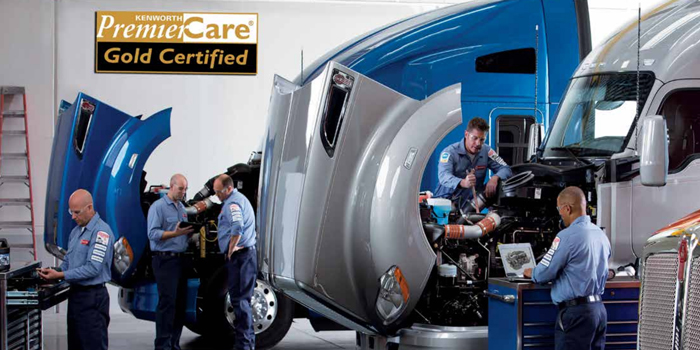Over the past few years, most truck OEMs have begun to implement dealer certification programs that supply advantages to dealerships that meet certain criteria. These criteria vary, but they all are geared toward the goal of having more efficient, productive shops.
Even if you’re not an OEM-affiliated repair shop, there is still a lot to learn from these programs. After all, they emphasize speedy triage programs, consistency and standardization across the shop management system, communication with customers and taking advantage of technology—each of which is a goal every shop.
Take Volvo Trucks North America’s Certified Uptime Dealer program, for example. It aims to address extended downtime by dealing with shop capacity issues.
On average, a repair that takes three-and-a-half hours means that the truck is down for four days. According to Volvo, this number was the main impetus in creating the CUD program.
“One very important requirement of the program is a dedicated uptime bay. This is crucial,” says Ash Makki, product marketing manager for Volvo Trucks North America. “We realize that dealers are not just going to go add capacity out of nowhere. You have to really work with what they have in terms of real estate. So we ask them to dedicate one of their bays for repair jobs that will take less than four hours. Once they know that, the truck goes immediately to that bay so we are avoiding the mentality of first come, first served.”
There are 30 other requirements that a shop must meet to become a Certified Uptime Dealer for Volvo or Mack. And Volvo keeps a close eye on certified dealers.
To start, Volvo sends a team to evaluate the shops to find out what is needed to meet the CUD standards.
On average, a repair that takes three-and-a-half hours means that the truck is down for four days.
Overall, the process of becoming certified for this program takes about five to six months. Once a dealership has it, they have to maintain it. Makki notes that it’s possible to lose certification.
In fact, every OEM offers some variety of a maintenance and repair incentive program for dealers and customers.
Kenworth offers two service programs, PremierCare and PremierCare Gold.
“PremierCare Gold is a superior level of service that offers extended dealer operating hours and expedited expert diagnostics, among other services, that assist customers in maximizing uptime and overall vehicle performance,” Kurt Swihart, Kenworth’s marketing director, says. “The Kenworth PremierCare Certified Gold program is driving the customer support level higher as Kenworth dealers invested millions of dollars in facilities in 2018, added service technicians, increased PACCAR engine training, and expanded evening and weekend service hours to achieve the program’s more stringent requirements.”
According to Swihart, 163 of Kenworth’s 400-plus dealerships are now PremierCare Gold Certified.
Daimler Trucks North America (DTNA)’s program is known as Elite Support. All Elite Support dealers must implement Express Assessment programs (DTNA’s term for triage), and meet 123 specific criteria across 20 customer service areas to qualify, and need to be re-certified every year.
International dealerships make use of the OnCommand Service Partner program, through which the dealerships post repair estimates to an online portal for customers to view. The program also offers fixed labor times for specific repairs at all International dealers and expedited service.
Also available from International is OnCommand Repair Advocate, a concierge system connecting customers, dealers and Navistar support groups through an online case file system to expedite repairs.
Peterbilt also offers maintenance and repair services including Rapid Check, a recently-launched rapid assessment service that provides diagnostics at Peterbilt dealer locations in two hours or less.

How dealerships reacted at first
The most difficult part of making a major change is the beginning. You have to know what steps to take, to know that those steps are going to bring you closer to your goal, and most importantly, you have to stick to them. You need buy-in from everyone in the organization. It can be a difficult transition, and there may be some resistance at first or a tendency to lapse back into the old way of doing things.
“We started with the Elite Support program in August of 2011,” says Heather Groleau of Truck Country of Iowa and Wisconsin, a Daimler Trucks network of dealers. “At first, our service advisers keyed in on Express Assessment, but it wasn’t going well. We weren’t remembering when to start and stop that clock; Elite Support didn’t survive that definition of: ‘What is an express assessment?’; completing proper write ups and diagnosing was not going well; foremen were resistant; and just overall, there was a lack of communication.
“But,” she continues, “we had a turning point in 2015 when we re-launched the Express Assessment commitment. We had a clearer definition of what meant: all vehicles requiring diagnosis. Service advisers were starting to complete the proper writeups in order to assist our technicians in diagnosing, so we started to get some momentum there and gain strength.”
Once the foundation was laid, adjustments were made to bring the service up to snuff.
“We obviously had to make adjustments at our dealership,” Groleau says. “We had to have career paths for our technicians. We had to have training programs. We even started to do a bonus programs and referral programs for our teams to beef up that level of commitment within our employees to get the trucks in and out the door, and make sure we have the right staffing to promote customer excellence.”
Other dealers with whom FST spoke had similar stories to tell: that the beginning can be difficult, but that once you get buy-in, you’ll start to see positive results that let you know all these changes were worth it.
“When the program was first introduced, it was a little rough for the first six months or so,” Volvo’s Makki admits, “but then we had some of our major dealerships get into the program, and that wheel just started turning. They started to see the benefits: the image of the dealership is changing; their service bays are clean; their technicians are more relaxed. Having things standardized has really made it easier to improve the areas that they need to have improved.”
The benefits
“The biggest benefit for the customers is the upfront communication when they come in,” Volvo’s Makki says. “We plug in to the truck immediately, within the first 30 minutes, run a quick diagnostic of the truck and determine how long the repair will take so we can let them know.”
A lot of work, Makki notes, is done by the agents at the Volvo Trucks Uptime Center in Greensboro, N.C., freeing up the shops to work on getting the trucks fixed as quickly as possible without getting bogged down by ancillary duties.
“The service manager could call the Uptime Center, assuming they are part of our remote diagnostic bundle for services, and the Uptime Center does all of that chasing around for parts availability so the service manager can worry about the service side of the business,” Makki says.
Steve Spihlman, director of service operations for Truck Centers Inc., a Daimler Trucks dealership, points out that of the 10 dealerships in his network, two are not Elite Support certified and are recent acquisitions—and he says that by the numbers, the differences between the Elite Support locations and those that are not certified yet are significant.
“When I look at all of our dealers that are Elite Support certified and practice Express Assessment on a regular basis, average first technician punch is between less than an hour to three hours,” Spihlman says. “When I look at the two locations that don’t practice that, they’re at 15 and 20 hours. So that culture has not reached them yet to understand what this does for the customer to drive that business.”

Not just for OEM dealerships
You don’t need to be an OEM dealer or part of an OEM program to improve your own service operation. You just have to commit to the culture and to the processes that can make it happen.
The bullet points of these transitions:
- Dedicate time and space to quick repairs;
- Standardize the way the shop run; and
- Utilize a shop management system.
These should be achievable by any shop, fleet-owned or independent, of any size.
But remember:
“This does not happen overnight,” Truck Country’s Groleau says. “We were Elite Support-certified in 2011, and we are just now feeling like we’re dialing in to some of these initiatives that branch through Elite Support and tackling what we need to tackle in order to provide the right customer service. It takes a long time, but at the end of the day when you start picking off these certain specific processes and slowly gaining strength with your team, we start to achieve some really excellent goals here.”
“The No. 1 advantage is increased driver and customer satisfaction,” Volvo’s Makki says. “For the dealerships, there are a lot of incentives. Being a Certified Uptime Dealer is really a culture change. The standardization of the processes makes it more efficient.”














